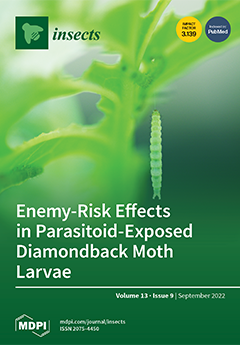Grapholita molesta, the oriental fruit moth, is a serious pest of fruit trees with host transfer characteristics worldwide. The gut microbiota, which plays a crucial part in insect physiology and ecology, can be influenced by many elements, such as antibiotics, temperature, diet,
[...] Read more.
Grapholita molesta, the oriental fruit moth, is a serious pest of fruit trees with host transfer characteristics worldwide. The gut microbiota, which plays a crucial part in insect physiology and ecology, can be influenced by many elements, such as antibiotics, temperature, diet, and species. However, the effects of antibiotics on
G. molesta gut microbiota are still unclear. In this study, we selected five common antibiotic agents to test the inhibition of
G. molesta gut microbiota, and found ciprofloxacin shown the best antibacterial activity. After feeding 1 μg/mL of ciprofloxacin, the relative abundance of Actinobacteria and Cyanobacteria decreased significantly, while that of Firmicutes and Bacteroidetes increased. PICRUSt2 analysis indicated that most functional prediction categories were enriched in the
G. molesta gut, including amino acid transport and metabolism, translation, ribosomal structure and biogenesis, carbohydrate transport and metabolism, transcription, cell wall/membrane/envelope biogenesis, and energy production and conversion. Finally, ciprofloxacin feeding significantly affected larval growth, development, and reproduction, resulting in prolonged larval development duration, shortened adult longevity, and significantly decreased single female oviposition and egg hatchability. In addition, we isolated and purified some culturable bacteria belonging to Proteobacteria, Firmicutes, Actinobacteria, and cellulase-producing bacteria from the
G. molesta midgut. In brief, our results demonstrate that antibiotics can have an impact on
G. molesta gut bacterial communities, which is beneficial for host growth and development, as well as helping female adults produce more fertile eggs. These results will thus provide a theoretical reference for developing new green control technology for
G. molesta.
Full article






